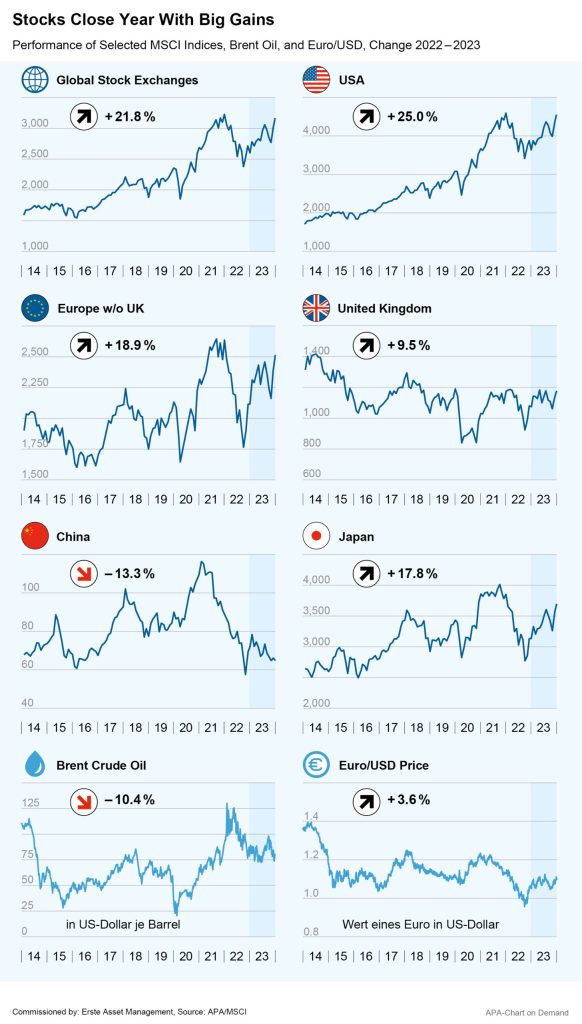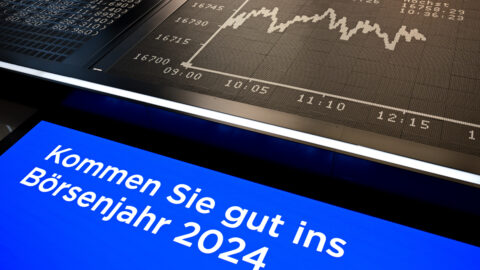
The international stock markets closed out 2023 with significant gains. Hopes of abating inflationary pressure and declining interest rates were the main market drivers in Q4, resulting in a strong year for stock exchanges. The Euro-Stoxx and the German DAX gained nearly 19 and 20% respectively in 2023, while gains in the British FTSE were somewhat more subdued at just under 4%.
The US stock markets can also look back on a good year 2023, with the Dow Jones and S&P 500 increasing by 14% and 24% respectively, and the technology-focused Nasdaq rising even more sharply. The Nasdaq Composite gained 43%. In Asia, the picture was less clear. While the Japanese Nikkei gained 28%, the Chinese CSI-300 fell by 11%.
Above all, the prospect of falling key interest rates fuelled a year-end rally on the stock markets, driving several indices such as the DAX and Dow Jones to new all-time highs. In view of the significant rise in energy prices and inflation rates since the war in Ukraine, central banks had been maintaining their restrictive course for an extended period, keeping interest rates high in the fight against inflation. This was compounded in autumn by fears of an escalation of the situation in Israel.
Note: Past performance is not a reliable indicator of future performance.

Falling Energy Prices and Inflation Rates Give Hope for Interest Rate Cuts
Towards the end of the year, however, hopes burgeoned that falling energy prices and easing inflationary pressure would pave the way for interest rate cuts in 2024. The price of crude oil dropped significantly, with the price of a barrel (159 litres) of Brent crude falling from just under USD 95 in September to between USD 75 and USD 80 by the end of the year.
Against this backdrop, inflationary pressure also declined further. The mean eurozone inflation rate was 2.4 per cent in November, down from 10.1 per cent a year earlier. This means that inflation has almost reached the ECB’s target value of 2.0 per cent, giving investors hope for a possible end to the restrictive interest rate policy.
Similar signals from central bankers also recently fuelled hopes of interest rate cuts and acted as a driver for the stock market rally. Although the US Federal Reserve recently confirmed its key rate at between 5.25 and 5.50 per cent, Fed Chairman Jerome Powell also signalled that interest rates would be cut soon. On average, the central bankers assume that the key interest rate will fall by 0.75 percentage points next year.
Soft landing could succeed
This has also boosted confidence on the stock markets that an impending recession in the USA can be averted. According to recent statements, US Treasury Secretary Janet Yellen expects the central bank to manage such a soft landing. Stock market participants are also hoping for interest rate cuts from the ECB, although ECB President Christine Lagarde attempted to dampen expectations of imminent cuts at the last interest rate meeting.
Technology shares benefited especially strongly from hopes of interest rate cuts in 2023, with the corresponding Euro Stoxx sector index increasing by nearly 30 per cent. IT companies, whose credit-financed major projects often only amortise after several years, are considered to be particularly sensitive to interest rate levels, although shares from the construction, media and banking sectors as well as automotive manufacturers also performed well in 2023. The few losers included oil and commodity stocks as well as stocks from the food and healthcare sectors.
China’s stock markets suffered from an uneven economic recovery
Contrary to the general trend, Chinese stock markets performed weakly. The second-largest economy after the US is suffering from weak global demand and the ongoing property crisis, after strict coronavirus restrictions had put a severe damper on the country’s domestic consumption for a long time. China has already put together several economic stimulus packages to strengthen the economic recovery after the coronavirus pandemic. Analysts assume that policymakers will need some more time to assess the impact of the latest fiscal support and the renewed efforts to revive the struggling property market.
Japan’s stock market, on the other hand, had its best year since 2013, with Japanese equities benefiting from factors such as the weak yen and the central bank’s continued low interest rate policy.
Gold price reaches record highs, bonds gaining
Away from the stock markets, some other asset classes also posted strong gains in 2023. The price of gold benefited from the prospect of falling interest rates and reached new record highs of around USD 2,140 per troy ounce in December.
The bond markets also saw gains as interest rate cut fantasies take hold. Bond yields fell significantly at the end of the year, reflecting expectations of falling interest rates, and conversely, bond prices increased. The yield on ten-year German government bonds fell below 2.0 per cent at times towards the end of the year. And due to the high interest rates in Germany, corporate bonds also saw increased demand.
For a glossary of technical terms, please visit this link: Fund Glossary | Erste Asset Management
Legal note:
Prognoses are no reliable indicator for future performance.
Legal disclaimer
This document is an advertisement. Unless indicated otherwise, source: Erste Asset Management GmbH. The language of communication of the sales offices is German and the languages of communication of the Management Company also include English.
The prospectus for UCITS funds (including any amendments) is prepared and published in accordance with the provisions of the InvFG 2011 as amended. Information for Investors pursuant to § 21 AIFMG is prepared for the alternative investment funds (AIF) administered by Erste Asset Management GmbH pursuant to the provisions of the AIFMG in conjunction with the InvFG 2011.
The currently valid versions of the prospectus, the Information for Investors pursuant to § 21 AIFMG, and the key information document can be found on the website www.erste-am.com under “Mandatory publications” and can be obtained free of charge by interested investors at the offices of the Management Company and at the offices of the depositary bank. The exact date of the most recent publication of the prospectus, the languages in which the fund prospectus or the Information for Investors pursuant to Art 21 AIFMG and the key information document are available, and any other locations where the documents can be obtained are indicated on the website www.erste-am.com. A summary of the investor rights is available in German and English on the website www.erste-am.com/investor-rights and can also be obtained from the Management Company.
The Management Company can decide to suspend the provisions it has taken for the sale of unit certificates in other countries in accordance with the regulatory requirements.
Note: You are about to purchase a product that may be difficult to understand. We recommend that you read the indicated fund documents before making an investment decision. In addition to the locations listed above, you can obtain these documents free of charge at the offices of the referring Sparkassen bank and the offices of Erste Bank der oesterreichischen Sparkassen AG. You can also access these documents electronically at www.erste-am.com.
Our analyses and conclusions are general in nature and do not take into account the individual characteristics of our investors in terms of earnings, taxation, experience and knowledge, investment objective, financial position, capacity for loss, and risk tolerance. Past performance is not a reliable indicator of the future performance of a fund.
Please note: Investments in securities entail risks in addition to the opportunities presented here. The value of units and their earnings can rise and fall. Changes in exchange rates can also have a positive or negative effect on the value of an investment. For this reason, you may receive less than your originally invested amount when you redeem your units. Persons who are interested in purchasing units in investment funds are advised to read the current fund prospectus(es) and the Information for Investors pursuant to § 21 AIFMG, especially the risk notices they contain, before making an investment decision. If the fund currency is different than the investor’s home currency, changes in the relevant exchange rate can positively or negatively influence the value of the investment and the amount of the costs associated with the fund in the home currency.
We are not permitted to directly or indirectly offer, sell, transfer, or deliver this financial product to natural or legal persons whose place of residence or domicile is located in a country where this is legally prohibited. In this case, we may not provide any product information, either.
Please consult the corresponding information in the fund prospectus and the Information for Investors pursuant to § 21 AIFMG for restrictions on the sale of the fund to American or Russian citizens.
It is expressly noted that this communication does not provide any investment recommendations, but only expresses our current market assessment. Thus, this communication is not a substitute for investment advice.
This document does not represent a sales activity of the Management Company and therefore may not be construed as an offer for the purchase or sale of financial or investment instruments.
Erste Asset Management GmbH is affiliated with the Erste Bank and austrian Sparkassen banks.
Please also read the “Information about us and our securities services” published by your bank.


